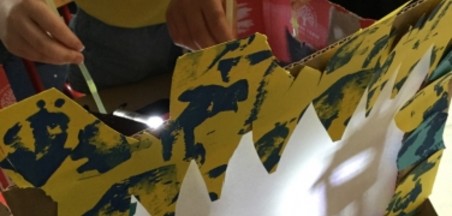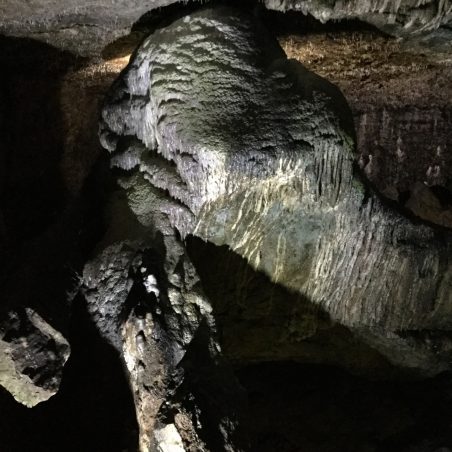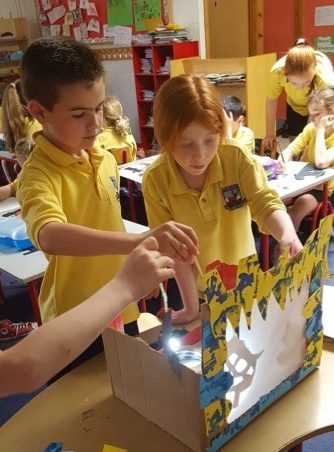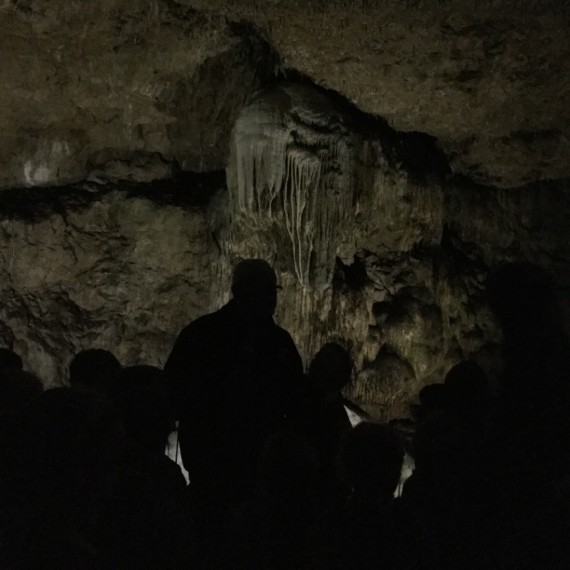Refine by Region
Refine by Art Form
Refine by School Level
Teacher-Artist Partnership (TAP) Project – Cave Dweller
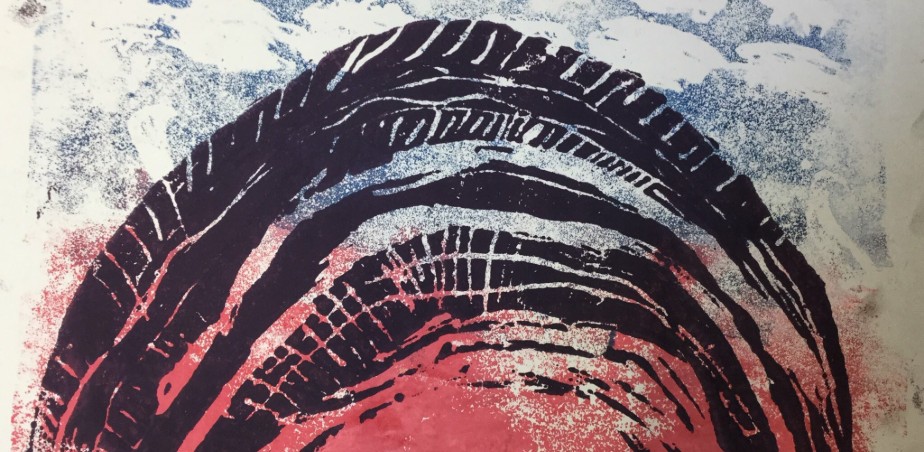
Teacher-Artist Partnership (TAP) is a unique Department of Education and Skills initiative for supporting and enhancing arts in education in primary schools. The CPD Summer Course and residency programme is now mainstreamed and consists of free DES approved (EPV days) Summer Courses operating in each of the 21 full-time Education Centres in Ireland. The initiative includes funded Artist in Residency opportunities in which participating teachers and artists work together in collaboration in the School during the following academic year.
For more information click here.
Tell us the story of your project – What was the impetus? What was it about? Who was involved? How did you begin?
The project was grounded by both Liselott and John’s backgrounds. This was informed firstly by exploring the cultural heritage of Sweden, particularly in relation to folktale and oral histories. John presented work on his own practice as a printmaker, children saw firsthand how a printmaker renders a copperplate or woodblock. A single print ‘Cave’ by Mamma Andersson became the stimulus, linking cross curriculuar themes such as geography, history, drama, literacy and maths. Participants engaged in multi-plate print processes, exploring the textural possibilities of relief printmaking. Responding to a site visit in Dunmore caves, pupils visually investigated geological formations, while researching the historical context of the cave in relation to folklore. A diorama became the backdrop to shadow play that was constructed over a number of sessions, echoing the interior space of the cave. Tapping into imagination participants played out theatrical scripts that responded to a series of narratives.
How were the ideas developed and how did the young people, artist and teacher work together?
John Busher, Artist
The project was developed over a number of sessions prior to the workshops beginning. The intention was to integrate numberacy and literacy, but also investigate the possibility of cross curricular activity. Following intital meetings it was decided to exlopre the cultural heritage of Sweden, the birthplace of class teacher Liselott. The project was developed in response to the activities; this usually involved a brief meeting following certain sessions to evaluate outcomes. Participants worked in small groups, where print stations were set up and amended to their needs. Liselott carried out research in between sessions with the group, children engaged in written activities that investigated folk tradition of Sweden. Other written activities responded to a site visit to Dunmore cave. There was a shared sense of balancing research with practical activity throughout the workshops with John.
Liselott Olofsson, Teacher
At the start of the project John introduced Mamma Anderson the print maker. We looked at her work both with John and outside of the workshop. The children learnt about her as an artist and we discussed her work in terms of themes, style, her use of colour etc…The children looked at Johns work as an artist and printmaker . We discussed where we see print in our environment, the children learnt to use ink and rollers by learning to monoprint outside the engagement with the artist. We also read folkstories. John had a book of Swedish folktales and in between the sessions we read those and discussed the theme, characters etc.
Before our trip to the caves we looked again at Mamma Anderson’s work and discussed the theme of caves. We talked about what a cave might smell like, feel like and look like. We picked out stories that featured caves such as ‘We are going on a Bear Hunt’. We talked about the different types of animals that could live in the caves. We looked at the caves on google maps to see where it was located and discussed the history of how the cave was found.
After the trip to Dunmore caves in Kilkenny, we reviewed what we had learnt about the caves and the children described the caves. We made a list of vocabulary associated with the caves and the children wrote a report on their visit and drew a diagram of the caves. We talked about how water can affect rocks and used the vocabulary -stalactites and stalagmites – to label the diagrams. At the end of the project the children had developed characters, which became shadow puppets. They had experience of reading scripts through using Readers Theatre and they discussed how they would create a script in groups for their characters.
What was your personal experience of the project in terms of successes and challenges?
John Busher, Artist
As a practicing artist, it was a pleasure to engage the children in the investigative process that an artist often goes through. From gathering initial research, documenting work both written and visual, through to the various stages that sees an artwork come into fruition. The onsite visit to Dunmore Cave brought richness to the project; this could not be achieved by working in the classroom alone. Planning for the sessions were only ever one week in advance, using this approach meant that I was responding to conversations that would happen with children in the classroom. This process often mirrors how I might work in the studio, responding to work made that day. The idea for a diorama grew out of the initial print process of making a cave print and linking with the local environment. As a visual artist I had no experience in script writing, it was a wonderful experience to see how the children responded to work in written form. Under Liselott’s guidance, children explored an incredible range of narratives through pair work. It was exhilarating to witness the children’s awe in exploring this through shadow play.
Having very little fluent speaking Irish was challenging at times, as conversations were often difficult to follow. It did allow an exchange where the children were directing me somewhat, which allowed me to build art terms and vocabulary through Irish. Demonstrating was often most challenging, articulating the various art-making processes and linking this with the content of the work. As the project progressed I became more fluent in how I delivered the sessions, this was a rewarding process ultimately and I found myself learning more about the children I was working with. The success of the project meant that Liselott and I have continued to work on the project in the context of the AiE summer course delivered in partnership with Wexford and Kilkenny Education Centres. The project has become a template in how to achieve successful teacher / artist partnerships, and the importance of cultivating this special relationship.
Liselott Olofsson, Teacher
The timing of the workshops was a challenge. We started at the beginning of May and as a teacher this time until the end of the school year can be hectic. I played a supportive role to John in the classroom. John instructed the children and at the start I was trying to translate this into Irish as the children are in a gaelscoil. This was interrupting the flow of the workshop so we decided that I would give the children the vocabulary in the following days. This was time consuming too.
It was a successful project as the children engaged in it over 2 months. There were 8 sessions of face-to-face workshops with the artist. Having a theme that was capable of expanding into the different curricular areas was rewarding and enriching for the children. Investigating their own locality was really important and learning about the history and geography of the region deepened the learning experience for the children.
The project also had many challenges. The project was started in May and continued until the end of June. This time of the year as a teacher, we are juggling assessments, school trips and other end of year school activities. The workshop lasted 2 hours for each session. We had to adjust our timetable to suit the artist.
What was significant for you about the project that is worth sharing?
John Busher, Artist
The project was exceptionally rich in terms of relating the working activities of a practicing artist. Children engaged in similar methodologies that artists would in their studio. Such as research, testing, exploring materials, reviewing and editing and traveling on site to gather visual research. The project demonstrated that children of any age could sustain their interest over a prolonged period of time. Each session I would bring a range of works in progress from the studio, often these were failed works other times they were pieces that I felt were successful. This process allowed a space where children felt it was possible to fail and work through their difficulties in the classroom, this was part of the natural process in art making. The children’s natural curiosity, their doubts, insecurity, highly charged energy and critical thinking are not too far from how an artist experiences the process of making art.It was a privilege to share this experience in the context of their classroom.
Liselott: The children had an experienced artist whose main passion is printmaking working with them for a sustained amount of time. This allowed a deeper engagement with the project. The children were able to build a relationship with the artist and secondly develop their own skills, language and work in a way that encouraged them to ask questions and not be afraid of making mistakes.
Has anything changed in your work as a result of the project?
John Busher, Artist
Integrating stimulating site visits into workshops as research has opened up a lot of possibilities regarding how participants engage with contemporary art. The practical aspect of artist research can be adapted successfully within the visual arts curriculum. The project also explored the similarities and differences between artists and teachers, and brought a more sensitive understanding regarding both roles. As an artist I am more familiar with facilitating as means of engaging children, this often involves demonstrating rather than direct instruction. Participating in the partnership has taught me a balance between direct instruction and demonstration. Artists engage children through inquiry based pedagogicalapproaches, as this method mirrors more closely how an artist might work. Having completed the residency I have found that there is a place for other pedagogicaltechniques such as scaffolding in the context of a workshop setting.
Liselott Olofsson, Teacher
Embracing a theme across a number of weeks allows a deeper engagement with both the theme and also a process. As a teacher there is pressure to move quickly through the curriculum to cover all processes and subjects. Allowing the children time to reflect and to experience a process in this case print over a number of weeks I saw how more capable the children had become in using the equipment and using the vocabulary to express themselves. The children were more confident and took more ownership of the process.
Spotlight
Artist(s):
John Busher, Artist
I am a visual artist who practices in mediums of drawing, painting and print. I was recently selected to participate in the Turps Correspondance Course at Turps Art School. Recent groups shows include GIFC (US), 0-0 LA, Los Angeles, Paper Cuts (UK), Saatchi Gallery, London, and Beep Painting Biennial, elysium gallery, Swansea. Recent solo shows include 'Jostle', Pallas Projects, Dublin. Recent awards include Artlinks Bursary Award, 2018, Wexford County Council.
As an arts facilitator I have worked on a number of high profile artist in schools projects, such as The Living Arts Project, Wexford County Council and Wexford Arts Centre. This is a long-term contemporary arts residency programme that culminates in four schools exhibiting in Wexford Arts Centre. Other projects include engaging with CAMHS teen Mental Health Services (HSE), and also adult Mental Health Services (HSE). I am CPD facilitator on the CPD in Visual Art for Primary Teachers course at NCAD. This is a weeklong workshop that is run a number of times throughout the academic year, the aim of the course is to explore, extrapolate and integrate Literacy and Numeracy in Visual Art particularly through the media, content and techniques utilised in the Drawing, Clay and Fabric and Fibre strands.
Collaborative practice allows for a mutually meaningful engagement process to take place. This shared experience means that a number of different parties can bring their own particular skillsets to projects. It is this rich interchange that excites me, and the often-unpredictable outcomes that emerge from this.
NCAD: http://johnbusher.ie/index.php/artsed/ncad/
AiE: http://johnbusher.ie/index.php/artsed/aie/
Living Arts Project (2018): http://johnbusher.ie/index.php/artsed/ballygarrett-ns/
Living Arts Project (2016): http://johnbusher.ie/index.php/arts-facilitation/
Teacher(s):
Liselott Olofsson, Teacher
I am a Ceramic Artist and a Primary school teacher. I have been involved in CPD for teachers since 2008 with Kilkenny Education Centre. I facilitated a number of summer courses for teachers: Visual Art in the classroom, Literacy courses, teacher Artist Partnership. I have also co-facilitated a summer course with the Butler Gallery.
I am a practicing artist with an on-going studio practice. In the summer of 2018 I spent 9 weeks on a ceramics residency in Jingdezhen in China, supported by Kilkenny Arts Office. I have received a number of bursaries from Artlinks, Kilkenny Arts Office and Eigse festival Carlow.
I am collaborating on new work for a show in Vienna, Austria in October/ November 2019. Collaboration is an important part of both my teaching and artistic life. In both I value the input of the other, dialogue with others allows me to take on challenges and try new things. I enjoy the sharing of experiences and learning news ways of working through the collaborative process.
Other:
(Curator, agency, etc):

Artist(s)
John Busher

Teacher(s)
Liselott Olofsson
Artforms
School Level
School/
Participant Group
Gaelscoil Osraí, Loch Buí, Co. Kilkenny
No. Participants
28
Region
Age/Class
1st Class
Dates
May/June 2017
Weblinks
Leading Agency
Kilkenny Education Centre
Other Partners and/or Funders
Wexford Education Centre
Key themes/ lines of enquiry
Investigating local folklore through oral history, this involved a site visit to Dunmore caves.
Curriculum Strands
Visual Arts (Printmaking & Construction), Geography (Human & Natural Environments), History (Myself, Family & Local Culture), English (Oral language, Reading & Writing), Drama
As a practicing artist, it was a pleasure to engage the children in the investigative process that an artist often goes through.
John Busher, Artist
